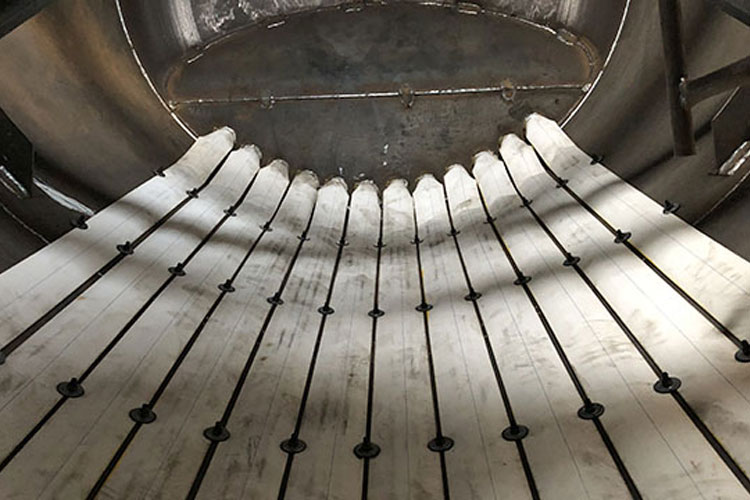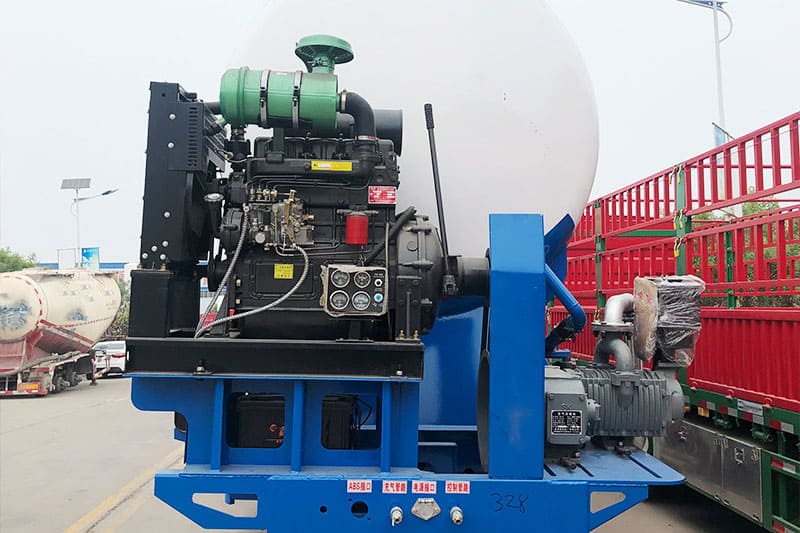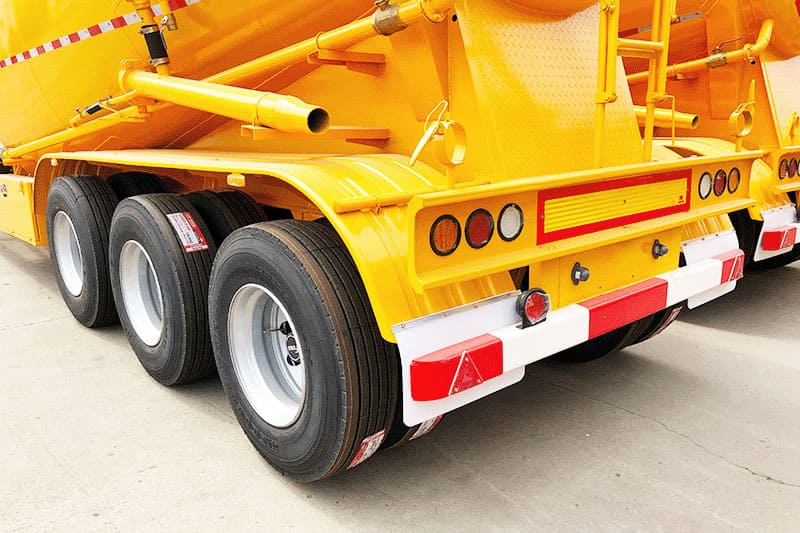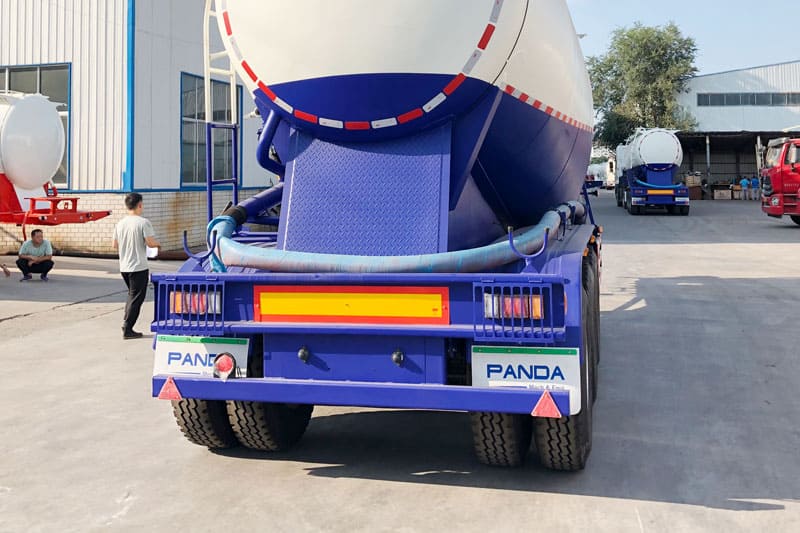- What is bulk cement used for
- Cement bulker composition
- Cement bulker material
- Cement bulker capacity
- Cement Bulker Type
- Inside cement bulker
- Cement bulker parts
- Pressure Relief Valve
- Pressure Gauge
- Bulk cement trailer air compressor
- Cement tanker blowers
- Cement trailer check valve
- Pressure Gauge
- Valves
- Fittings
- Cement bulker hoses
- Cement trailer tire
- Axles
- Suspension
- Toolbox
- Crash beam
- Cement trailer storage
- How to operate cement bulker?
- How does cement bulker work?
- How to maintain cement bulker
- How do I get cement bulker products?
The cement bulker is designed to transport cement from manufacturers to concrete mixing plants, warehouses, factories, construction sites, etc. in quantities of 25-120 tons. Using cement bulkers to transport cement is faster, safer, more efficient and easier to store than traditional transport methods.

What is bulk cement used for
Bulk cement is typically used in large-scale construction projects, such as the construction of bridges, roads, or dams. It is also used in the production of concrete, mortar, and grout.
Cement bulker is used for transporting cement, fly ash, lime powder, etc.
Cement bulker composition
The composition of a cement bulker depends on the type of cement being transported and the size and type of the bulker. Generally, a cement bulker is composed of a tank, chassis, compressor, blower, valve, axle, tire, suspension, leg, LED lights, and pipeline. The tank is typically made of steel and is designed to hold the cement.
Cement bulker material
Cement bulker is usually divided into carbon steel and aluminum, carbon steel is the most commonly used material, and most of the cement bulkers we have sold are made of carbon steel. However, for some countries with limited weight, it is often more appropriate to use aluminum cement bulkers.

Cement bulker capacity
Cement bulker capacity is from 25-120tons, 20-100cbm/m3. We can help you choose the best cement bulker configuration according to the cargo you need to transport, the distance you need to transport, and the local road conditions.
Cement Bulker Type
Cement bulker is divided into v type, w type, silo type. These are three different designs, their use is different, in different countries, the popular type of different, you can choose according to your needs, or we will help you to recommend.
V type
V type cement bulker is the most common type, this type is usually used very much in Africa, the material is usually carbon steel.

W type
W type cement bulker can be divided into single and multi-bin, which can be used to transport different kinds of goods.

Silo type
The silo type of cement bulker is very similar in appearance to the four tankers, here is the picture of the cement silo trailer.

Inside cement bulker

Cement bulker parts
Tank: This is the main component of a cement bulker trailer and is usually made of steel or aluminum. It is designed to hold the cement or lime powder.
Pressure Relief Valve
This valve is used to release pressure buildup in the tank and prevent over-pressurization.
Pressure Gauge
This device is used to measure the pressure inside the tank.
Bulk cement trailer air compressor
This is a device that increases the pressure of the air or gas inside the tank. It is used to push the material through the tanker’s pipes.

Cement tanker blowers
A cement tanker blower is a type of industrial machine used to blow cement into tank. The blower is usually mounted on the front of the truck and is used to fill the tank with cement. The blower works by forcing compressed air through a hose into the inside of the tank, usually the blower is powered by a diesel engine or an engine.
Cement trailer check valve
A cement trailer check valve is a type of valve used on cement trailers to prevents air from flowing backwards into the compressor, causing damage to the compressor and preventing it from performing normal work.
Pressure Gauge
This is a device used to measure the pressure inside the tank. It is important to monitor the pressure in order to ensure that the material is being unloaded safely.
Valves
These are used to control the flow of material through the tanker’s pipes. They can be manually operated or automated.
Fittings
These are used to connect the hoses to other equipment. They are typically made of brass or steel.
Cement bulker hoses
These are used to connect the cement bulker tanker to the warehouse.
Cement trailer tire
Cement bulker truck tires are constructed with a heavy-duty rubber compound that is designed to withstand the weight of the trailer and the abrasive nature of the materials being transported.

Axles
Cement bulker truck axles are designed to provide a smoother ride and increased capacity for carrying large volumes of bulk materials. They are typically constructed from steel and feature large-diameter wheels and tires, as well as a heavy-duty suspension system.
These axles are designed to provide a higher level of strength and stability, while also providing a smooth ride for the trailer and its contents.
Suspension
Pneumatic bulk trailer suspensions are designed to provide a smooth ride and excellent load stability for bulk trailers. The suspension system also includes a shock absorber to reduce bounce and sway.
Toolbox
A cement bulk trailer toolbox is a storage box that is typically mounted on the side of a pneumatic dry bulk trailer. It is designed to store tools and supplies needed to maintain and operate the trailer. The toolbox can be made from a variety of materials such as aluminum, steel, or plastic.
It is important to choose a material that is strong and durable enough to withstand the rigors of the road. The toolbox should also be equipped with a secure locking mechanism to keep tools and supplies safe.
Crash beam
A cement bulker trailer crash beam is a structural component that is designed to absorb the kinetic energy of an impact from a collision and protect the cargo inside the trailer.
It is typically made from high strength steel to help dissipate the energy of the impact. The crash beam is typically located at the end of the trailer and is designed to absorb the impact of a collision and protect the cargo inside the trailer from damage.

Cement trailer storage
Cement trailers can also be used as a way to store bulk cement. When there is no storage place for bulk cement temporarily, using a cement trailer is also a good way.
How to operate cement bulker?
- Check the condition of the cement bulker before use. Make sure that all parts are in good working order, including the brakes, tires, and suspension.
- Connect the cement trailer to the tractor.
- Load the cement into the cement bulker. Follow the instructions for loading the cement.
- Drive the cement bulker to its destination. Follow all applicable laws and regulations while driving.
- Unload the cement. Follow the manufacturer’s instructions for unloading the cement.
- Clean the cement bulker. Make sure to clean the cement bulker after each use to prevent buildup of cement residue.
How does cement bulker work?
Loading:
- Before opening the cement bulker trailer manhole cover, one step you need to do is to first open the pressure relief valve to drain the pressure inside the tank. If you don’t, there can be pressure inside the tank, which makes opening the manhole cover a very dangerous thing.
- Open the cement bulker manhole cover.
- Load the cement or other powder and granular material goods into the cement tanker trailer tank.
- When the loading is finished, check the seal first and remove some magazines from the seal to make sure the powder tanker seal is tight when closing the manhole cover.
Unloading:
- Open all the inlet valves of the cement bulker, usually, you can find each on both the front and the back.
- Close these valves: the pressure relief valve, external source valve, blowing valve and unloading butterfly valve.
- Start the bulk cement trailer air compressor, and fill the tank with compressed air to increase the pressure inside the tank.
- When the tank pressure reaches 0.2Mpa, you can close the secondary blowing valve to increase the unloading speed.
- Make sure the cement bulk carrier truck discharge pipe is not blocked before closing the blowing valve.
- Connect the discharge hose to the cement silo and open the discharge butterfly valve to start unloading.
- The unloading speed of air compressor is 1.5T/min, usually, 50 ton cement trailer takes 35 minutes to finish unloading, but in order to avoid problems, it usually runs for a longer time.
- When unloading is finished, turn off the compressor and engine.
- Open the pressure reducing valve and close the discharge butterfly valve.
- Disconnect the discharge port from the vehicle and finish unloading.
How to maintain cement bulker
- Check the air pressure in the tires and adjust it if necessary.
- Check the brakes and make sure they are in good working condition.
- Check the oil level and top off if necessary.
- Check the suspension and look for any signs of wear or damage.
- Check for any signs of rust or corrosion on the body and frame.
- Check the lights and make sure they are in working order.
- Check the hoses and belts for signs of wear or damage.
- Check the filters and replace them if necessary.
- Check the air compressor and change the oil regularly.
- Inspect the interior of the bulker and make sure everything is in good working order.
How do I get cement bulker products?
We are a cement bulker factory for more than 20 years. We invest a lot of manpower and resources in research and development every year to ensure that our cement trailer is at the world’s advanced level.
We supply 25-120 ton cement bulkers for sale. We can customize it according to your needs.
